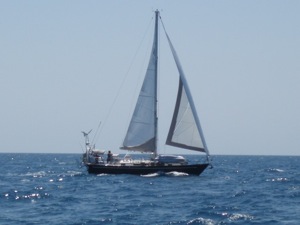Fuel management is always a big topic of interest to cruisers, commuter and full-time. From a commuter cruiser perspective there are basically two choices for fuel management while you’re away from the boat. You have to decide if you want to leave your fuel tanks FULL when you leave every year or EMPTY. There are commuter cruisers that will support either way, so despite the fact that many will try to convince you there’s only ONE correct way, it’s simply not true.
We always top off our diesel tanks to the max just prior to leaving each year. When cruising in the NW or SW Caribbean where the availability of diesel is not assured, it’s important to take advantage of clean diesel any time you can get it. We like to buy diesel from anywhere that sells a lot of it … usually dive locales are good selections or even shrimp boat fleets – but only during the season. Diesel that just sits in a station’s tanks can lead to even worse issues than our sailboat which typically uses a quarter of our onboard diesel or less in a cruising season. We always take the time to filter the fuel with a baha filter even though it slows the process considerably. If we’re at a busy location where they prefer we not take so long, we’ll put the diesel in jerry cans and then transfer it with the baja filter.
We don’t know the ideal answer to the diesel question, but 0ur solution to the ongoing debate is to leave our tanks full to keep the diesel dry … i.e. deliberately limit the amount of air that can infiltrate the tank. Air creates condensation, which creates little water droplets and water contamination. Water contamination adds “fuel” (so to speak) to bacterial growth, resulting in eeooey gooey junk otherwise known as slime that can and will clog your fuel filters at the absolutely worst time possible … for instance, after you’ve sailed all night and dead tired and are just getting ready to go in a reef pass known to be tricky with an immediate hard right just inside the pass (San Pedro Belize) — yep, it happened to us.

Even though we keep the tanks full, we add a biocide and a stabilizer when we leave the boat to try and reduce the amount of gunk the tank accumulates over the summer. The biocide helps limit the amount of condensation and the stabilizer inhibits oxidation. According to the Sta-Bil (the brand of stabilizer we use when available): “Stored fuel can go bad in as little as 30-60 days causing gum, varnish and corrosion to build up in the fuel lines and engine”. Guess what will also clog fuel lines!!!
Everything we’ve read recommends making sure your diesel fuel is kept at a cool even temperature. Somehow the environment we leave our boat in as commuter cruisers violates everything about that recommendation! It’s HOT, it’s HUMID and it’s not even an “even” temperature.
Ideally, we would clean the tanks every year before we leave the marina to go cruising. Unfortunately, whoever designed the fuel tanks (we have two) in the Passport 37 didn’t really think much about cleaning the tank. One of our tanks is in the keel – great location … central, weight low, etc. BUT, baffles? Whoever thought baffles in vertical and horizontal orientations were a good idea? Maybe it is a good idea, but maybe baffles need inspection ports too? We actually do have inspection ports in both of our diesel tanks, but in the keel tank, it doesn’t help much. You cannot clean below the baffles with any level of confidence that you’ve cleaned up the gunk you need to reach. I guess the baffles do keep the sludge from sloshing around quite as bad in rough seas, but we’d rather be able to CLEAN the bottom of that tank. We clean the tank that’s under the starboard settee much more regularly.
We know lots of cruisers that do clean their tanks annually before they leave to go cruising. This is the main argument for leaving the tanks empty – easy to clean when you return. And if you’re going to thoroughly clean them upon returning, it’s probably a pretty good solution. We’d love to be able to clean the bottom of BOTH our tanks!
We even know some cruisers that leave their tanks full, then siphon all the diesel into jerry jugs to clean the tanks before returning it to the tanks. Probably the ideal solution, but a bit on the high maintenance side! 🙂
We clean our tanks as thoroughly as possible under the circumstances which is not good enough. After having them professionally cleaned right before leaving the US, we added a “fuel polishing” system to the boat. Basically a pump and a giant Racor filter, the fuel polishing system helps keep our diesel cleaner, maybe not perfect, but cleaner is better than dirtier! We run the fuel polishing system on both tanks upon our return and some years we’ve had our caretaker run the fuel polisher monthly for long enough to filter all the fuel a couple of times (about 2 hours in our case). We’ll also run the fuel polisher underway from time to time just because fuel in tanks underway is stirred up alot more than fuel in tanks at a dock with a little fuel polishing pump running!
While we were out of the US cruising, we always kept both tanks topped off … mostly because you never knew if the next place fuel was available would be out of fuel for weeks on end. It seemed like just because there was a fuel dock (or gas station) didn’t insure there would be fuel available! Not something you worry about a lot when cruising US waters! Now that we’re temporarily back in SW Florida, we opted to empty the keel tank and use only the starboard tank for diesel. Since we rarely use more than part of one of the tanks, it just seemed like a good idea not to let both tanks get gunky while we were gone.
While we both would feel much better if we could clean the very bottom of that elusive keel horizontally baffled tank, our strategy has worked for us.
How do you handle fuel when you leave the boat for an extended period? Leave a comment and let’s hear how others manage this challenge!
THANKS! Jan













